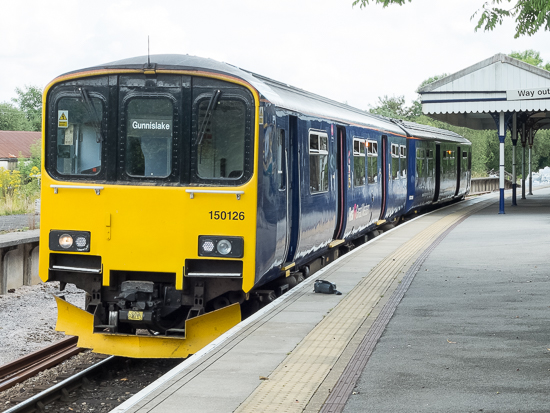Having already travelled over the Royal Albert Bridge linking Devon and Cornwall I decided to travel under it (by rail, not river) with a trip up the 'Tamar Valley Line' to Gunnislake.
The line splits off the West of England main line west of Plymouth at St Budeaux Junction and winds its way up the Tamar estuary to Bere Alston before reversing onto the line to Gunnislake passing over the Calstock Viaduct (and into Cornwall) roughly three miles from Gunnislake station.
 150126 at Bere Alston, 6/8/14
150126 at Bere Alston, 6/8/14
I hopped off the train at Bere Alston and snatched a quick photo of 150126 as the guard abandoned his ticket machine on the platform and went off to change the points for the line to Gunnislake completely missing this!
 Bere Alston signalbox, 6/8/14
Bere Alston signalbox, 6/8/14
Having swapped sides for the journey back to Plymouth I spotted the signalbox on the now disused island platform as the train pulled back into Bere Alston and I detrained once more to investigate. A London & South Western Railway type 3b box dating from 1890 it was closed in 1970 and is now apparently used by the owner of the former station-master's house… I'm not sure what for but wouldn't it make a superb summer house?
Bere Ferrers is the last station before the line re-enters the Plymouth suburbs and is home to The Tamar Belle, a small railway heritage centre that also offers overnight accommodation in a pair of London & North Eastern Railway carriages! Sadly, a lack of time prevented a visit but I managed to take a photo of a couple of the centre's locomotives before continuing on my way.
 Hunslet Engine Co Ltd 0-4-0DM (works no.3133 of 1944) and Peckett & Sons Ltd 0-4-0ST 'Hilda' (works no.1963 of 1938) at the Tamar Belle Railway Heritage Centre, Bere Ferrers, 6/8/14
Hunslet Engine Co Ltd 0-4-0DM (works no.3133 of 1944) and Peckett & Sons Ltd 0-4-0ST 'Hilda' (works no.1963 of 1938) at the Tamar Belle Railway Heritage Centre, Bere Ferrers, 6/8/14
Information on this pair is sketchy but the diesel is a Hunslet Engine Co Ltd product, an 0-4-0DM and believed to be works no.3133 of 1944, supplied new to the Admiralty's Lodge Hill & Upnor Railway in Kent and subsequently moved to the Admiralty depot at Bullpoint, Plymouth in 1962. The 0-4-0ST was built by Peckett & Sons Ltd in 1938 as works no.1963 and I would welcome any details as to its history.
 High Street signalbox, Lincoln, 22/12/14
High Street signalbox, Lincoln, 22/12/14 East Holmes signalbox, Lincoln, 22/12/14
East Holmes signalbox, Lincoln, 22/12/14















































